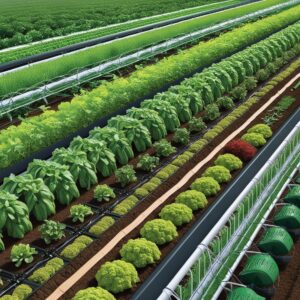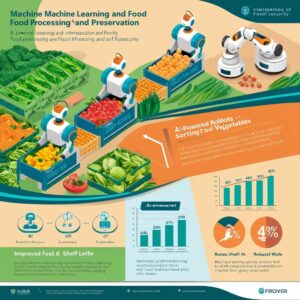Introduction
In today’s agriculture, there’s a growing demand for innovative solutions that can handle both the increasing need for food and the challenges of labor shortages. Autonomous platforms, or self-operating robotic systems, have emerged as a groundbreaking response in orchards and vineyards. These platforms are equipped with advanced sensing, navigation, and decision-making technologies that allow them to perform essential tasks without human intervention, making agricultural operations not only efficient but also safer and more sustainable. In this article, we explore the various techniques that enable these platforms to work seamlessly in agricultural settings, simplifying tasks and supporting farmers in the field.
1. The Core of Autonomous Navigation in Agriculture
Autonomous platforms in agriculture must navigate through complex, dynamic environments, like orchards and vineyards, where plants, trees, and even humans can change the layout daily. The journey to full autonomy relies on two foundational abilities: navigation and manipulation. For navigation, these platforms need a strong awareness of their exact location and the surroundings. This helps them to make decisions on where to go, avoid obstacles, and execute tasks effectively.
Key Point: Autonomous navigation focuses on giving platforms the “sight” and “sense” they need to work independently and safely.
2. Positioning Techniques: Absolute and Relative Approaches
- Absolute Positioning: Most autonomous agricultural platforms use Global Navigation Satellite Systems (GNSS), including GPS and other satellite systems. However, standard GPS accuracy (2–4 meters) is often insufficient for the precise work needed in agriculture, where spacing between rows can be less than a meter. Enhanced GNSS methods like Real-Time Kinematic (RTK) positioning or Satellite-Based Augmentation Systems (SBAS) improve accuracy to within a few centimeters, critical for tasks in densely planted orchards or vineyards.
- Relative Positioning: When satellite data isn’t enough, platforms rely on relative positioning—estimating their position by recognizing nearby objects, plants, or even markers placed specifically for navigation. This technique, which often combines visual cues from cameras and data from LiDAR, enables platforms to make localized adjustments for even better precision in movement and task execution.
Actionable Tip: For farms in areas with unreliable satellite signals, using a combination of RTK and relative positioning enhances navigational accuracy.
3. Advanced Sensing Systems: The Eyes and Ears of Autonomous Platforms
To make informed decisions, autonomous platforms rely on a variety of sensors that act as their “eyes and ears”:
- Cameras: RGB cameras (standard in many devices) and 3D imaging are essential for understanding environments visually. Cameras can be used for fruit picking, soil analysis, and even distinguishing plants from weeds.
- LiDAR and 3D Imaging: Light Detection and Ranging (LiDAR) systems help create 3D maps of the surrounding terrain by measuring distances to nearby objects. This mapping capability is valuable for creating precise layouts, identifying obstacles, and even analyzing plant growth.
- Hyperspectral and Infrared Imaging: Hyperspectral sensors pick up wavelengths beyond visible light, useful for assessing plant health. Infrared sensors, particularly through the Normalized Difference Vegetation Index (NDVI), can detect live vegetation, making it easier to identify plants and ensure they are thriving.
- IMU and Ultrasound: Inertial Measurement Units (IMUs) use accelerometers and gyroscopes to maintain stability and orientation, and ultrasound helps in obstacle detection, especially at close range.
Actionable Tip: Consider platforms equipped with LiDAR and infrared imaging for more reliable obstacle detection and plant health assessments.
4. Data Processing and Decision-Making Algorithms
After gathering data from sensors, platforms process this information using complex algorithms to decide their next steps. These algorithms interpret data on location, obstacles, and plant health, then determine the most efficient and safe path forward. With the help of machine learning, many of these platforms can “learn” from past experiences, optimizing operations like fruit picking or weeding based on previous outcomes.
Key Insight: Platforms equipped with decision-making algorithms reduce the need for constant human supervision, allowing farmers to focus on other critical aspects of crop management.
5. Path Planning and Optimization
For platforms to operate efficiently in vast orchards or vineyards, path planning is essential. This involves calculating the shortest and safest paths to complete tasks, optimizing for both time and energy. Advanced path-planning systems consider field layouts, plant density, and even weather conditions, ensuring that the platform’s actions are both resource-efficient and effective.
Actionable Tip: Path-planning technologies can be highly beneficial for farms with large areas, reducing travel time and fuel consumption.







6. Commercial and Emerging Technologies in Agriculture
Several commercial platforms are already transforming the agricultural landscape. These systems come with various sensors and technologies designed to meet specific needs—whether for orchards, vineyards, or other specialized crops. Many companies are also investing in emerging technologies, like machine learning and AI-driven sensors, to further enhance platform capabilities.
Examples: Some of the well-known technologies include Real-Time Kinematic (RTK) positioning systems for high-accuracy navigation and hyperspectral imaging for real-time health assessments.
Summary for Social Media Content Creation
Key Takeaways for Instagram Reels and Canva Infographics:
- Introduction: Highlight the benefits of autonomous platforms in agriculture—precision, safety, and efficiency.
- Absolute Positioning: GPS and GNSS for basic positioning; RTK for high accuracy.
- Relative Positioning: Using cameras and LiDAR to recognize plants and obstacles.
- Sensing Systems: Cameras, LiDAR, hyperspectral, and infrared for in-depth field analysis.
- Algorithms: Data-driven decisions for optimized navigation and task performance.
- Emerging Tech: AI and machine learning for continuous improvement in operations.
Table (Example)
| Technology | Function | Application |
|---|---|---|
| RTK Positioning | High-accuracy GPS | Precision navigation |
| LiDAR | 3D mapping | Obstacle detection and layout |
| Infrared | Detects live vegetation | Health monitoring, obstacle avoidance |
| Hyperspectral | Beyond visible light detection | Plant quality and nutrient mapping |
| IMU | Stability and orientation | Detecting rough terrain |
Conclusion
Autonomous platforms are leading agriculture into a future where efficiency, precision, and sustainability go hand in hand. Through advanced positioning, innovative sensing technologies, and intelligent algorithms, these systems empower farmers to meet growing demands while safeguarding resources. Embracing these technologies isn’t just about automation—it’s about creating a sustainable, productive agricultural landscape for generations to come.
This section provides an insightful overview of decision-making and control systems in autonomous platforms, especially in agriculture. Here’s a summary of the key points covered:
- Decision-Making: Autonomous systems in agriculture must make decisions concerning safety and task planning. Safety-related decisions prioritize minimizing risks to humans, crops, and the machine itself. In human-robot interactions (HRIs), safety protocols are crucial, especially for avoiding accidents, which often stem from human errors. Task planning focuses on optimizing resource use, such as energy, and adapting to task-specific needs (e.g., weed detection, path planning).
- Data Processing: Effective decision-making relies on efficient data interpretation, filtering out irrelevant data to enhance the value of the remaining information. For example, depth sensors like LiDAR can approximate shapes for obstacle detection. Data from sensors may be stored and mapped, allowing future actions to consider historical context (e.g., fertilizer application history).
- Control Systems: Control systems in autonomous platforms regulate behavior. Closed-loop systems use real-time sensor feedback to correct errors, while fuzzy control systems handle non-binary inputs, mimicking human-like adjustments (e.g., steering intensity). These systems enhance stability and adaptability, essential for autonomous navigation and task precision.
- Path Planning and Optimization: Route planning in agriculture considers multiple variables, such as vehicle size and fuel capacity. Sophisticated algorithms tackle these complex problems (NP-hard), though real-time solutions prioritize efficiency over absolute optimality.
- Fleet Management: Autonomous fleets can operate under centralized or decentralized control. Centralized control offers comprehensive oversight, making it easier to coordinate tasks across multiple vehicles but may struggle with scalability. Decentralized control enables individual vehicles to make local decisions based on their surroundings, promoting scalability but with less efficiency and coordination.
- Existing Technologies: The section reviews current innovations in agricultural robotics:
- Vitirover: Solar-powered robotic lawnmowers for weed management in vineyards and orchards.
- GUSS: Autonomous sprayer focusing on operator safety and fleet operation.
- Naïo TED: A vineyard weeder with versatility for other tasks like trimming.
- VINBOT & VineScout: Monitoring platforms providing data on vine health, essential for data-driven agricultural decision-making.
- RHEA: A fleet of heterogeneous robots aimed at reducing chemical use, improving crop health, and lowering costs.
- Future Outlook: Autonomous platforms are expected to address labor shortages, environmental impact, and efficiency in agriculture. Fleet-based automation and smart implements (e.g., drones for data analytics) are poised for expansion, promising a more sustainable and data-oriented approach to farming.
These insights suggest that as technology continues to advance, autonomous agricultural systems will likely play an increasingly vital role in sustainable farming, labor management, and environmental conservation. For a detailed exploration of this topic, refer to this comprehensive article.
About Us
Welcome to Agriculture Novel, your go-to source for in-depth information and insights into the world of agriculture, hydroponics, and sustainable farming. Our mission is to educate, inspire, and empower a new generation of farmers, hobbyists, and eco-conscious enthusiasts. Whether you’re interested in traditional farming practices or modern innovations, we aim to provide comprehensive guides, expert tips, and the latest updates in agriculture and urban farming.
At Agriculture Novel, we believe in the power of knowledge to transform the way we grow, sustain, and nourish our world. Explore our articles on topics like Fruit Growing Guide, Hydroponics, Plant Deficiency Guide, and more.
Thank you for joining us on this journey towards a greener, more sustainable future!
About Agronique Horizon
At Agronique Horizon, we specialize in delivering comprehensive digital marketing and web development solutions tailored for the agriculture and hydroponics industries. From custom website design and app development to social media management, we provide end-to-end support for brands aiming to make a meaningful impact. Our team also offers innovative solutions for the real estate sector, bringing precision and visibility to your projects. Learn more about our services here and discover how we can elevate your digital presence.



